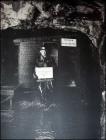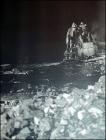1
During the life of the mines, working conditions were difficult and dangerous. Drilling was done by dry-drilling causing constant presence of dust. This dust was so thick that the miners could not see one another unless they were standing directly next to each other. The dust use to clog the men's nostrils, eyes and mouth causing them to have great difficulty breathing. In some sections of the mine, the air lacked so much oxygen that one could not light a match.The mine water, which leaked into the mine at the rate of 2000 gallons per minute, reduced dust levels somewhat, but soaked the miners to the skin. In the summer this was a nuisance, in the winter it made the 3-mile walk home unpleasant. The water placed a strain on the pumps and hydroelectric plants. During the summer the plants could barely keep the mine dry, let alone power the mills, electric lights and other facilities.
Alcan became interested in St. Lawrence fluorspar as a source of material in 1939 for its smelter at Arvida, Quebec.
In December, Alcan acquired mineral claims in the St. Lawrence area and formed a subsidiary, Newfoundland Fluorspar Limited, or "Newfluor." By the spring of 1940, Newfluor had hired 50 men to undertake work at a large-deposit known as "Director" vein.
During a April 1940 walkout, union president Pat Alyward testified that in the past only the "dread of poverty" had kept workers from complaining more openly about working conditions at the mines. The problems that he listed included a lack of sanitation facilities and clean drinking water, inadequate mine ventilation, which had caused "Suffocation" in many cases, dangerous substandard hoisting equipment, and a common practice of working a man so hard that he soon became disabled, to the extent, he had to be replaced on the job.
One miner had testified that the hoisting systems at the "Black Duck" mine were very dangerous and that the only source of drinking water was from a hose that supplied water to cool the air compressors.
Another miner testified that in the "Iron Springs" shaft, the only source of ventilation was the hoses that supplied compressed air to the machinery. Workers would remove a hose from a piece of equipment and breathe air from it. Because of this, men fainted underground for lack of air.
Another miner testified that the manager, Donald Poynter, an American, employed by Seibert, had threatened to fire miners if they complained about the working conditions.
In June 1940, A.E. Cave of the Ontario Department of mines, on his second visit to inspect the St. Lawrence Mines made the following recommendations on health and safety issues, including hoisting practices, explosives, rock falls, and escape routes, but he also mentioned clean drinking water and toilet facilities were needed.
2
Jack Keating underground in the dynamite storage area, 250' underground.1933-1978
St. Lawrence, Newfoundland and Labrador, Canada

3
Miners cleaning up the muckpile in the 506 stope1933-1978
St. Lawrence, Newfoundland and Labrador, Canada
